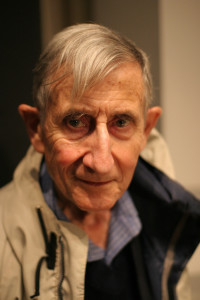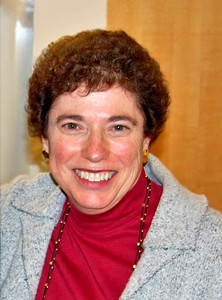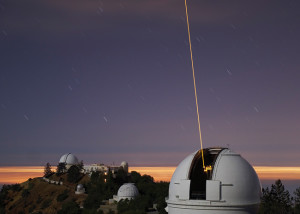In this writeup I focus on two people’s contributions to the development of adaptive optics. I’ve left out many important names so that I could briefly highlight Dr. Max’s contributions in the context of the Weber Prize. An international cast of scientists and engineers have made modern AO what it is today.
JASON (no relation) is a small, elite, civilian group of scientists that advises the government on science and technology, mostly through classified studies for the DoD, DoE, and the various intelligence communities. Its members have developed many important concepts for these agencies, many of them now declassified.
One of the members, Claire Max, is known to many astronomers as the director of the University of California Observatories. There’s an amazing story about how astronomy changed forever that starts back in the 70’s that involves JASON, Dr. Max, Freeman Dyson, Ronald Reagan… well, let’s start at the beginning.
In the early 1960’s, the undisputed polymath and genius Freeman Dyson (yes, that Freeman Dyson) was a member of JASON, and worked on many projects for them. According to his commentary here, In 1972 Harold Lewis suggested that Mr. Dyson develop a theory for a control system that could help a telescope correct for the blurring effects of the Earth’s atmosphere. This would allow satellites to take clearer pictures of the ground, and telescopes to take clearer pictures of satellites. Mr. Dyson found the problem interesting, and, once the project was declassified, wrote a prescient 1975 paper on the subject, exploring the limits of the sharpness of images while looking through the atmosphere.
Mr. Dyson tried to persuade astronomers, first in the US, later in Europe and Russia, to pursue the technology, but he couldn’t arouse their interest (perhaps the problem was still too hard from a technical perspective? Or perhaps the prospect of exquisite images of only the very brightest stars was not sufficiently enticing). Mr. Dyson speculated that (true) rumors that the US military was developing the technology made “re-inventing the wheel” seem like a waste of time. Then Ronald Reagan announced the Strategic Defense Initiative (“Star Wars”), classifying much of the research on the area and confirming those rumors. Dyson writes that “this action set back progress in adaptive optics by ten years.”
Meanwhile, Claire Max, another JASON, was working on the problem of adaptive optics, and lamenting that it could only be used on bright targets with lots of photons. Typical astronomical sources were very faint, and so the limits Mr. Dyson had calculated for them were quite poor, meaning that astronomers could not necessarily use the technology. Working (as I have heard the story) with other JASON members, Dr. Max developed a technology to shoot an orange laser into the upper atmosphere that would excite the layer of sodium atoms there. These glowing atoms would shine back down, giving astronomers the photons they needed to calculate the distortions caused by the atmosphere. With this “laser guide star adaptive optics” technology, the entire sky could be made as clear and sharp as quantum physics allows, despite the atmosphere.
In 1991, Dr. Max finally succeeded in getting the technology declassified, and then started work at Lawrence Livermore National Laboratory outfitting the Shane 120-in telescope at Lick Observatory with a laser adaptive optics system, a program that succeeded in 1996. When I was a grad student at Berkeley, I often saw the Shane shooting its orange laser into the sky all night as I worked on the CAT.
Dr. Max would go on to edit the Keck “blue book” design study, an outline for how to build the most successful AO system possible for existing technology. This template was used for the successful Keck laser AO system that Dr. Max was intsrumental in bringing about (and which Andrea Ghez would use to weigh the supermassive black hole at the center of the Milky Way, essentially proving that black holes exist). It’s also been followed for the Gemini Planet Imager, now imaging planets orbiting other stars, and other next-generation AO systems.
In 1999, UC Santa Cruz became host to the National Science Foundation Center for Adaptive Optics, which developed the technology further and trained a new generation of astronomers in the theory, design, and use of AO. Dr. Max helped propose the center and served as its director. The CfAO kept the US competitive with Europe in AO design, and generated many of the cutting edge technologies used today in AO.

The whole $1 billion Thirty Meter Telescope concept relies on being able to construct giant space lasers. Seriously.
Today, laser guide star adaptive optics is an essential technology for every large telescope in the world. It is the basis for the case for the next generation of extremely large telescopes like the Giant Magellan Telescope, the European Extremely Large Telescope, and the Thirty Meter Telescope. It allows astronomers to obtain space-quality images of any part of the sky, using the principles laid down by Freeman Dyson in the mid ’70’s.
So it is quite overdue, but welcome nonetheless, that the AAS has awarded Claire Max the 2015 Joseph Weber award for Instrumentation. The citation is “for co-inventing sodium laser guide star adaptive optics and for shepherding adaptive optics from its roots in classified space surveillance to its prominence today as an essential technology on large telescopes. Her leadership has truly advanced the field of adaptive optics and transformed how we observe by making near diffraction-limited imaging possible on large telescopes, thus opening new fields of discovery including resolving stars and gas near supermassive black holes and studying extrasolar planets.”
I’m not an AO guy, I was just around at Berkeley/Lick when a lot of the laser AO stuff was happening. Bruce Macintosh, Marshall Perrin, and Norbert Hubin all contributed to my understanding of the history of LGS AO, but any errors in the above are my own. If you know more about this history or see a mistake, please leave a comment!




